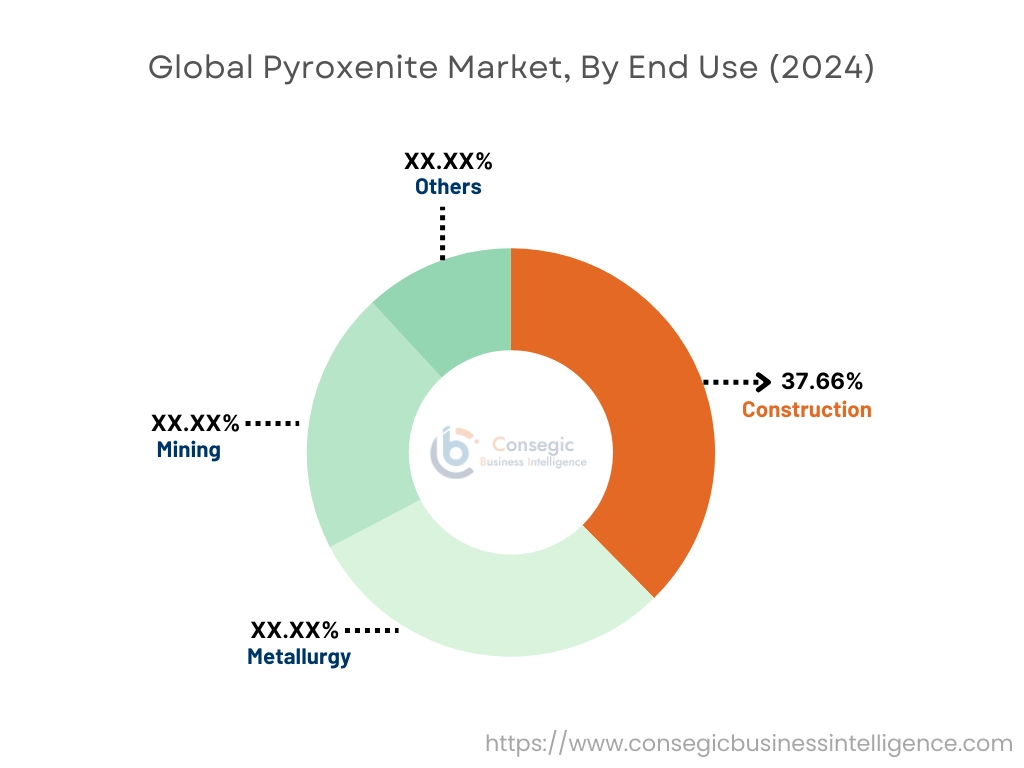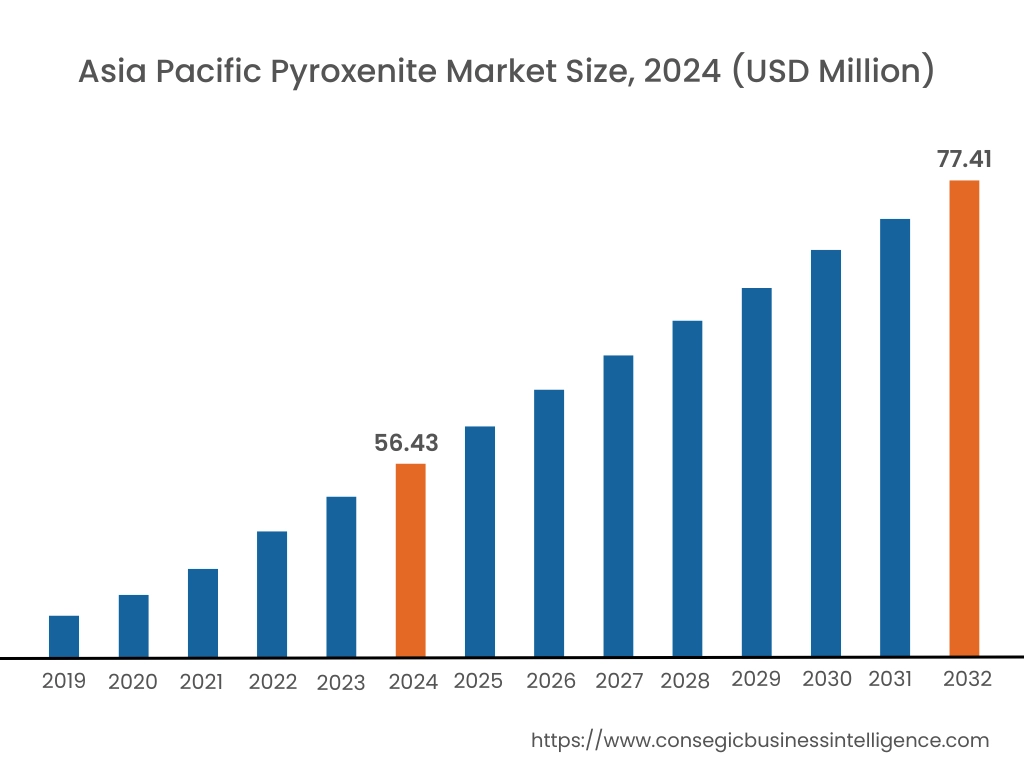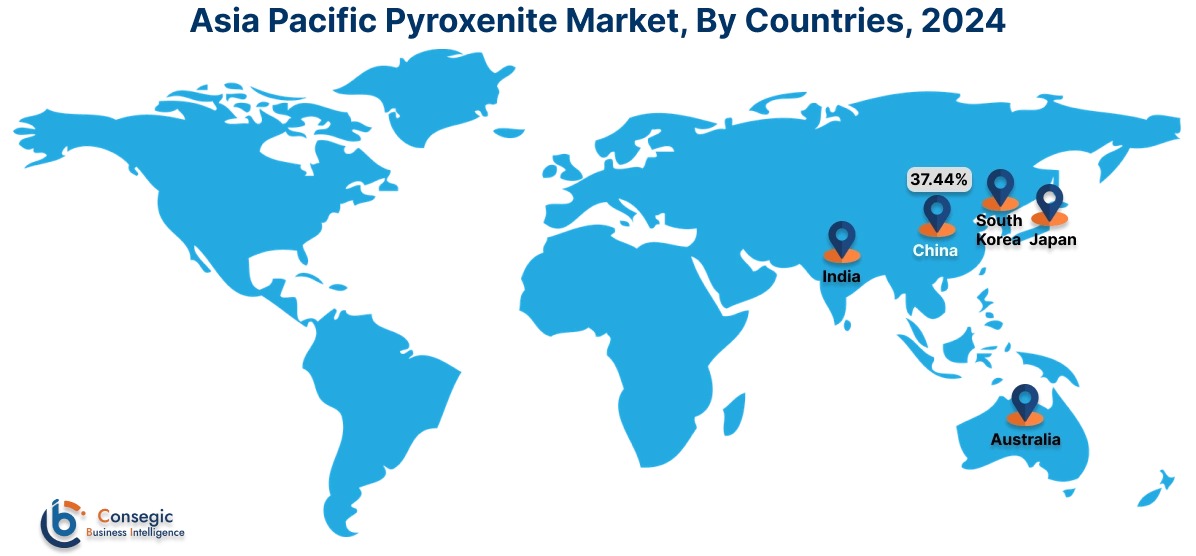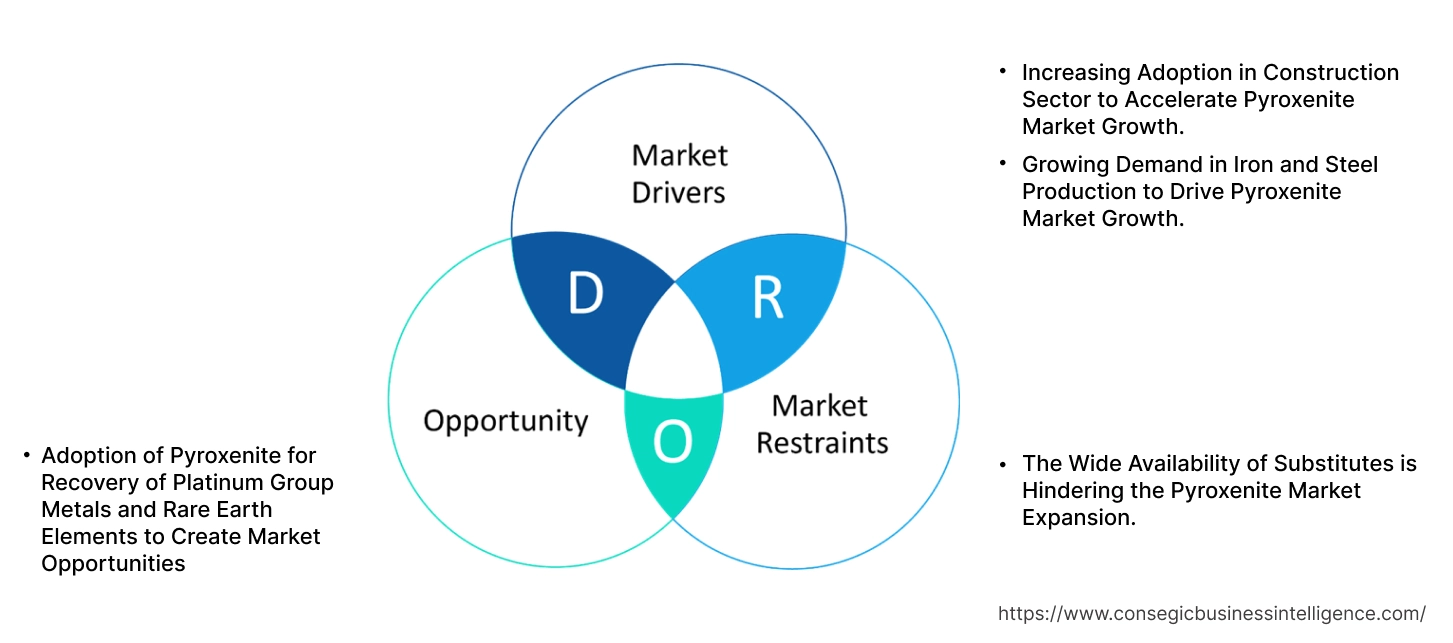- Summary
- Table Of Content
- Methodology
Pyroxenite Market Size:
The Pyroxenite Market size is growing with a CAGR of 4.7% during the forecast period (2025-2032), and the market is projected to be valued at USD 186.07 Million by 2032 from USD 129.56 Million in 2024. Additionally, the market value for 2025 is attributed to USD 135.15 Million.
Pyroxenite Market Scope & Overview:
Pyroxenite is classified as a coarse-grained igneous rock characterized by its predominant mineral composition of pyroxene minerals. It exhibits dark colors ranging from dark green to black due to its iron and magnesium-rich constituents. Its formation primarily occurs within layered igneous intrusions. Its hardness and durability makes it suitable for use as crushed aggregate. It is also used as a dimensional stone in several architectural and interior applications. Furthermore, rock material is increasingly utilized in the metallurgical sector as an effective fluxing agent in iron and steel production. Beyond these major applications, it plays a crucial role in the mining industry as the host rock for various economically significant minerals, including platinum group elements, chromium, and nickel.
Key Drivers:
Increasing Adoption in Construction Sector to Accelerate Pyroxenite Market Growth.
The inherent physical and mechanical properties of pyroxenite, which offer a combination of hardness and durability, are finding increased utilization within the construction sector. These properties make the rock suitable for crushing and application as an aggregate in concrete production and road construction projects. Additionally, the rock exhibiting attractive colors and textures is being processed into dimension stone. This caters to aesthetic requirements in building facades, paving, countertops, and various decorative applications in architecture and interior design. As global infrastructure development persists on an upward trajectory, the corresponding adoption of the material is also escalating,
- For instance, according to the data published by the United States Census Bureau, it is stated that total private non-residential construction spending that includes commercial construction accounted for USD 757.5 billion in 2025, which is 2.5% increase from 2024.
Thus, as per the market analysis, the increasing requirement for the material in construction applications is contributing to the pyroxenite market demand.
Growing Demand in Iron and Steel Production to Drive Pyroxenite Market Growth.
Pyroxenite provides advantageous properties as both a fluxing and sintering agent. This rock characterized by specific magnesium oxide (MgO) and silica (SiO₂) content is employed in blast furnaces. This offers several benefits, including enhanced slag conditioning and a reduction in energy consumption. Furthermore, pyroxenite serves as a sintering agent in the steelmaking process. It supports the agglomeration of fine iron ore particles into larger ones which are more suitable forms for blast furnace input. As the adoption of steel accelerates, the sector's requirement for the sintering agent increases, directly impacting market growth.
- For instance, according to World Steel Association AISBL, steel production across the globe including 71 countries increased by 5.6% from 2023 reaching 5 million tons in 2024.
Hence, as per the analysis, growing adoption of the rock material in iron and steel production is driving the market.
Key Restraints:
The Wide Availability of Substitutes is Hindering the Pyroxenite Market Expansion.
The expansion of the market for pyroxenite faces hindrance in the overall upward trajectory due to the widespread availability and established use of substitute materials across its applications. In the construction sector, conventional aggregates such as granite, basalt, limestone, and sand & gravel benefit from extensive distribution networks, local sourcing options, and well-defined quality standards. This reduces the reliance on extraction of pyroxenite. Similarly, granite, marble, sandstone, and slate serve as alternative dimension stones. Dolomite and limestone are established fluxing agents in iron and steel production processes. This abundance of readily available and often well-understood substitutes is supporting players to adopt alternatives. As a result, the above-mentioned factors are limiting the pyroxenite market expansion.
Future Opportunities :
Adoption of Pyroxenite for Recovery of Platinum Group Metals and Rare Earth Elements to Create Market Opportunities.
Pyroxenite formations host various platinum group metals (PGM), including platinum, palladium, rhodium, ruthenium, iridium, and osmium. As the use for PGMs rises due to their critical applications in catalytic converters, electronics, and other high-tech sectors, this rock material is becoming an increasingly important alternative source of these metals. Additionally, there is increasing interest in pyroxenite as a potential source for rare earth element (REEs), fuelled by their crucial role in green technologies and high-tech applications. Ongoing mining operations are exploring REEs from different ore types.
- For instance, in 2024, Rimfire Pacific Mining completed initial drilling at the Murga Exploration Target, intersecting scandium-prospective laterite and pyroxenite for the recovery of scandium.
Hence, this growth in the adoption of the rock material in the extraction of platinum group elements directly benefits the pyroxenite market demand.
Pyroxenite Market Segmental Analysis :
By Application:
Based on application, the market is categorized into metallurgical fluxing agent, building materials, refractories, and others.
Trends in the Application:
- Growing preference for pyroxenite over dolomite due to its lower CO₂ emissions in iron and steel production.
- Pyroxenite's hardness and regional availability support its use as a robust aggregate in infrastructure projects.
The building materials segment accounted for the largest pyroxenite market share in 2024.
- Owing to its hardness and resistance to wear, pyroxenite finds several applications across in building materials, primarily as a durable aggregate utilized in concrete mixtures, road construction base layers, and railway ballast.
- The varieties of this rock are processed into dimension stone, countertops, and decorative stone among others leveraging its visual characteristics.
- The growth in infrastructure development worldwide fuels the demand for robust aggregates.
- Additionally, the adoption of natural stones is rising owing to the growing demand for aesthetic appeal.
- Hence, owing to the above-mentioned analysis, building materials segment functions as the principal determinant of dynamics within the broader market.
The metallurgical fluxing agent segment is expected to grow at the fastest CAGR over the forecast period.
- A significant volume of pyroxenite is utilized as an effective fluxing agent in the iron and steel
- Its specific chemical composition consisting of MgO and SiO₂ offers advantages such as improved slag conditioning and lower CO₂ emissions.
- The large scale of production within iron and steel sectors necessitates a high volume of fluxing agents required in blast furnace operations.
- For instance, the Public Information Bureau of India stated that in fiscal year 2023-24, India's iron ore production reached 274 million metric tons (MMT). Production increased from 252 MMT during the April-February period of FY 2023-24 to 263 MMT during the corresponding period in FY 2024-25, representing a growth rate of 4.4%
- Consequently, the metallurgical fluxing agent segment is expected to grow at the fastest rate over the future years, creating pyroxenite market opportunities.
By End-Use:
The end use segment is categorized into metallurgy, construction, mining, and others.
Trends in the End Use:
- Growing focus on the adoption of green building materials is fueling the utilization of pyroxenite with distinctive colors and textures for aesthetic appeal in building facades, paving, and interior design.
- Rising preference for sustainable fluxing agents is positively impacting the adoption of pyroxenite.
The construction segment accounted for the Pyroxenite market share of 37.66% in 2024.
- The increasing utilization within the building stone and aggregate applications of the construction is the major factor that is creating lucrative options for pyroxenite in the market.
- The growing preference among architects and designers for natural stone materials with distinctive visual characteristics is supporting growth of the segment.
- The emerging interest in green building materials within the construction sector further positions the construction as a significant segment.
- For instance, according to the Dodge Construction Network, green renovations and retrofits of existing buildings yield substantial global performance, achieving operating cost reductions of 11.5% and 17%, respectively.
- Overall, as per the analysis, the construction segment holds a dominating share in the pyroxenite market trends.
The metallurgy segment is expected to grow at the fastest CAGR over the forecast period.
- Within the metallurgical sector, pyroxenite serves as a crucial material, primarily in the iron and steel sector. Functioning as a fluxing agent in blast furnaces, it supports the removal of impurities from iron ore by forming slag.
- In addition to this, it is utilized as a sintering agent in iron ore processing. In this process, the material supports the agglomeration of fine particles into more permeable sinters for blast furnace charging. This results in improved furnace efficiency.
- These applications offer several advantages over traditional fluxes. Hence, the adoption of the material as a flux is increasing globally as a cost-effective alternative for steelmakers.
- Overall, owing to the pyroxenite market analysis, the metallurgy segment is expected to hold the fastest growing position in forecast period.

Regional Analysis:
The regional segment includes North America, Europe, Asia Pacific, the Middle East and Africa, and Latin America.

In 2024, Asia Pacific accounted for the highest market share at 43.56% and was valued at USD 56.43 Million and is expected to reach USD 77.41 Million in 2032. In Asia Pacific, China accounted for a market share of 37.44% during the base year of 2024. Asia Pacific's influence on the market is significant due to the region being the major production hub for iron and steel sectors. Governmental initiatives in countries such as India and China aimed at stimulating their iron and steel production is supporting the market revenue. Additionally, the region's robust construction sector, particularly infrastructure development in developing economies within Asia Pacific are driving the demand for construction materials like aggregates and dimension stones.
- For instance, according to IBEF, the capital investment outlay for infrastructure in the Union Budget 2025-26 of India has been increased to USD 128.64 billion, representing 3.1% of the nation's GDP.
These factors create a strong upward trajectory for the Asia Pacific market trend, positioning it as a key region for players.

In Europe, the pyroxenite industry is experiencing the fastest growth with a CAGR of 5.4% over the forecast period. One of the key factors contributing to the region’s market revenue is the significant steel production across the European countries, creating an increased adoption of the material, for its use as a fluxing agent. Furthermore, technological advancements in the region are exploring the integration of the material into high-tech applications, particularly in the production of advanced alloys and catalysts. These factors collectively present a positive impact on the European market trend.
The North American market is significantly defined by a well-established construction industry in the U.S. and Canada. The region is also witnessing increased exploration and mining of pyroxenite due to its potential for rare earth elements and its use in nickel-cobalt projects along with enhanced extraction techniques that improve yield and efficiency. Furthermore, the presence of major steel manufacturing companies supporting the demand for material in metallurgical applications contributes to the region's market trend over the forecast period.
The Latin American pyroxenite market trend is driven by the region's focus on infrastructure development across major countries within the region, such as Brazil and Argentina. The rising iron and steel sector in the region is also creating significant potential for the market. Furthermore, the growing manufacturing and construction sectors in the region are contributing to the adoption of the material in applications such as building stone and aggregates. These aforementioned factors are contributing to the upward trajectory of the market trend.
The Middle East and African pyroxenite market analysis is currently characterized by increasing infrastructure development. Government investments in infrastructure projects across the Middle East, particularly in transportation and utilities, drives requirement for the material as an aggregate in construction. Majorly, the market is characterized by reliance on imports. This presents pyroxenite market opportunity to meet rising needs.
Top Key Players and Market Share Insights:
The Global Pyroxenite Market is highly competitive with major players providing products to the national and international markets. Key players are adopting several strategies in research and development (R&D) and product innovation to hold a strong position in the global Pyroxenite market. Key players in the Pyroxenite industry include
- Epiroc AB (Sweden)
- Daemo Engineering Co., Ltd. (South Korea)
- MSB Corporation (South Korea)
- Komatsu Ltd. (Japan)
- Rammer (Sandvik Group) (Finland)
Pyroxenite Market Report Insights:
| Report Attributes | Report Details |
| Study Timeline | 2019-2032 |
| Market Size in 2032 | USD 186.07 Million |
| CAGR (2025-2032) | 4.7% |
| By Application |
|
| By End-Use |
|
| By Region |
|
| Key Players |
|
| North America | U.S. Canada Mexico |
| Europe | U.K. Germany France Spain Italy Russia Benelux Rest of Europe |
| APAC | China South Korea Japan India Australia ASEAN Rest of Asia-Pacific |
| Middle East and Africa | GCC Turkey South Africa Rest of MEA |
| LATAM | Brazil Argentina Chile Rest of LATAM |
| Report Coverage |
|
Key Questions Answered in the Report
How big is the Pyroxenite market? +
In 2024, the Pyroxenite market is USD 129.56 Million.
Which is the fastest-growing region in the Pyroxenite market? +
Europe is the fastest-growing region in the Pyroxenite market.
What specific segmentation details are covered in the Pyroxenite market? +
By Application and End Use segmentation details are covered in the Pyroxenite market.
Who are the major players in the Pyroxenite market? +
Orex Mining Company DMCC (UAE), Tata Steel (India), and Anglo American (United Kingdom) are some of the major players in the market.


